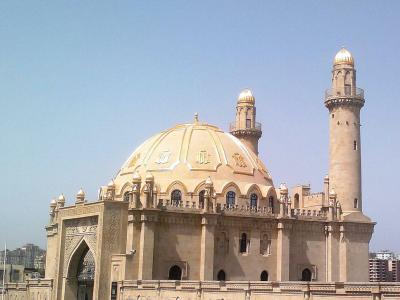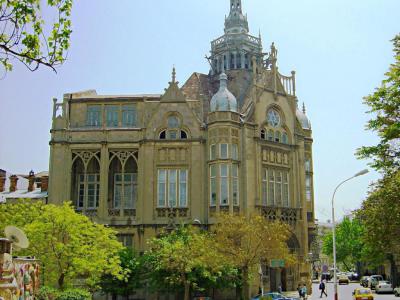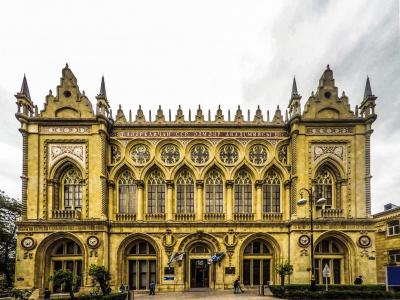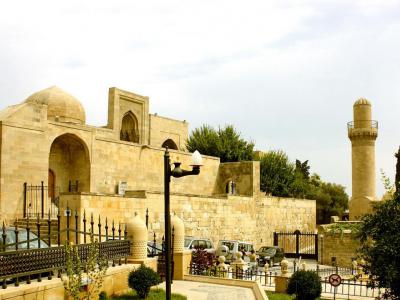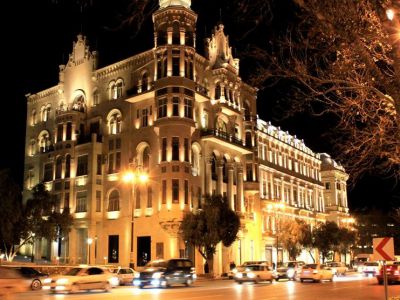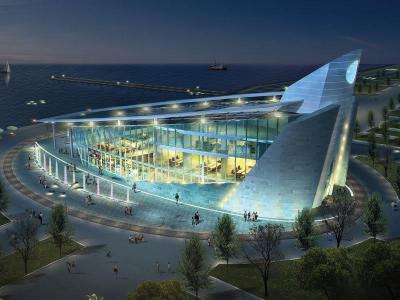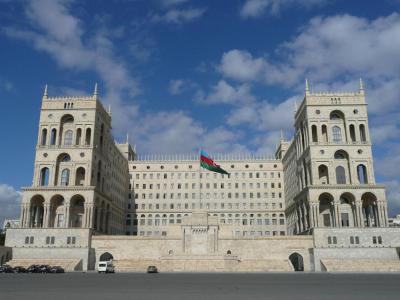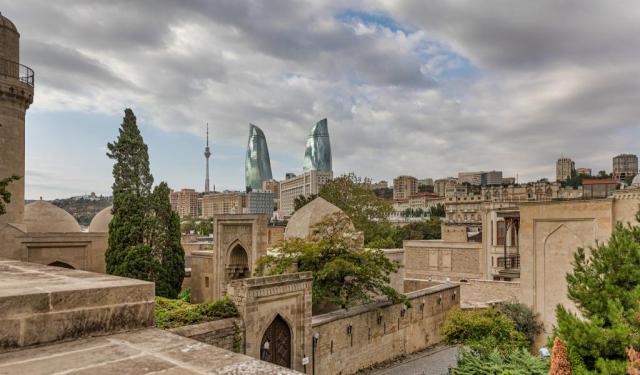Baku's Architectural Jewels (Self Guided), Baku
The city of Baku is an architectural marvel that delights with its historic buildings, grand mansions and cultural diversity. The Old City, for example, is full of fantastic old mosques and palaces that are listed as heritage monuments by UNESCO. The city is especially beautiful at night when it is wonderfully illuminated. Follow this self-guided walking tour to see the most impressive architectural sights in Baku.
How it works: Download the app "GPSmyCity: Walks in 1K+ Cities" from Apple App Store or Google Play Store to your mobile phone or tablet. The app turns your mobile device into a personal tour guide and its built-in GPS navigation functions guide you from one tour stop to next. The app works offline, so no data plan is needed when traveling abroad.
Baku's Architectural Jewels Map
Guide Name: Baku's Architectural Jewels
Guide Location: Azerbaijan » Baku (See other walking tours in Baku)
Guide Type: Self-guided Walking Tour (Sightseeing)
# of Attractions: 7
Tour Duration: 2 Hour(s)
Travel Distance: 3.8 Km or 2.4 Miles
Author: ellen
Sight(s) Featured in This Guide:
Guide Location: Azerbaijan » Baku (See other walking tours in Baku)
Guide Type: Self-guided Walking Tour (Sightseeing)
# of Attractions: 7
Tour Duration: 2 Hour(s)
Travel Distance: 3.8 Km or 2.4 Miles
Author: ellen
Sight(s) Featured in This Guide:
- Teze Pir Mosque
- Mukhtarov's Mansion
- Ismailiyya Palace
- Shirvanshahs Palace
- Hajinski Palace
- Baku Business Centre
- Government Building
1) Teze Pir Mosque
The Teze Pir Mosque, located in Baku, is a significant religious and architectural landmark, rich in history and cultural significance. Construction of the mosque began in 1905 and concluded in 1914, under the patronage of Nabat Khanum Ashurbeyova, a notable Azerbaijani philanthropist. The mosque stands on a site historically significant for its sanctuary that dates back to the 14th and 15th centuries, which originally housed the tomb of the revered Islamic scholar and saint, Abu Seyid Abdulla.
Architect Zivar Bey Ahmadbayov and builder Karbalai Ahmed led the mosque's construction, which showcased pioneering architectural techniques for Baku at the time, notably the use of white stone. The mosque's design incorporates features typical of Muslim Eastern architecture, marked by its square-shaped worship hall measuring 19.6 by 19.6 meters, adorned with large domes, porticos, and minarets. The interior is lavishly decorated with Azerbaijani paintings and eastern ornaments, including calligraphy from the Quran that adorns the walls and minarets.
Despite its initial closure three years after its inauguration due to the 1917 October Revolution, during which it served various non-religious purposes, the mosque was reopened for worship in 1943. It is currently presided over by the Grand Mufti of the Caucasus, Allahshukur Pashazadeh.
Significant restoration work from 2006 to 2009 modernized the mosque without compromising its historical essence. Enhancements included a ventilation system and the installation of a Namazgah carpet, accommodating up to 720 worshippers. The mosque's dome, crafted from Qızılqaya stone, is notably inscribed with the Shahada, the Muslim declaration of faith.
Architect Zivar Bey Ahmadbayov and builder Karbalai Ahmed led the mosque's construction, which showcased pioneering architectural techniques for Baku at the time, notably the use of white stone. The mosque's design incorporates features typical of Muslim Eastern architecture, marked by its square-shaped worship hall measuring 19.6 by 19.6 meters, adorned with large domes, porticos, and minarets. The interior is lavishly decorated with Azerbaijani paintings and eastern ornaments, including calligraphy from the Quran that adorns the walls and minarets.
Despite its initial closure three years after its inauguration due to the 1917 October Revolution, during which it served various non-religious purposes, the mosque was reopened for worship in 1943. It is currently presided over by the Grand Mufti of the Caucasus, Allahshukur Pashazadeh.
Significant restoration work from 2006 to 2009 modernized the mosque without compromising its historical essence. Enhancements included a ventilation system and the installation of a Namazgah carpet, accommodating up to 720 worshippers. The mosque's dome, crafted from Qızılqaya stone, is notably inscribed with the Shahada, the Muslim declaration of faith.
2) Mukhtarov's Mansion
The Mukhtarov's Mansion, also known as Palace of Happiness, is an emblematic historical building in Baku. Located centrally along Istiglaliyyat Avenue, this magnificent structure is an exemplar of Neo-Gothic architecture, a rare style in the region, reflecting the cosmopolitan influences of early 20th-century Baku.
Constructed between 1911 and 1912 by the wealthy Azerbaijani oil baron Murtuza Mukhtarov, the palace was intended as an extravagant gift for his wife, Liza-Khanum Tuganova. Inspired by the couple's travels across Europe, particularly in France, the design of the Palace was directly influenced by a French Gothic building that left a significant impression on Liza. Moved by her admiration for its architecture, Mukhtarov secretly arranged for a replica to be built in Baku, even procuring the original blueprints from France.
The architect behind this grand endeavor was Józef Płoszko, a Polish architect renowned for his contributions to Baku's architectural heritage. Under his guidance, the building rose swiftly over nine months, culminating in a surprise reveal to Liza, who was brought to the newly completed palace in a carriage.
A striking feature of the Palace is the statue of Zawisza Czarny, a legendary Polish knight known for his valor and honor, positioned above the entrance, symbolizing the noble aspirations behind the construction.
The building's history is marked by tragedy and change. Mukhtarov, defending his home, tragically ended his life during the Bolshevik occupation in 1920. Post-occupation, the building served various public functions, including as a women’s vocational club and a museum, before becoming the Palace of Marriage Registrations during the Soviet era. In 2001, it was officially recognized as a monument of cultural and historical significance by the Azerbaijani government.
After extensive restoration, the Palace of Happiness reopened in 2012 and continues to serve as a cherished venue for wedding ceremonies, embodying both the romantic origins of its creation and its enduring place in the heart of Baku.
Constructed between 1911 and 1912 by the wealthy Azerbaijani oil baron Murtuza Mukhtarov, the palace was intended as an extravagant gift for his wife, Liza-Khanum Tuganova. Inspired by the couple's travels across Europe, particularly in France, the design of the Palace was directly influenced by a French Gothic building that left a significant impression on Liza. Moved by her admiration for its architecture, Mukhtarov secretly arranged for a replica to be built in Baku, even procuring the original blueprints from France.
The architect behind this grand endeavor was Józef Płoszko, a Polish architect renowned for his contributions to Baku's architectural heritage. Under his guidance, the building rose swiftly over nine months, culminating in a surprise reveal to Liza, who was brought to the newly completed palace in a carriage.
A striking feature of the Palace is the statue of Zawisza Czarny, a legendary Polish knight known for his valor and honor, positioned above the entrance, symbolizing the noble aspirations behind the construction.
The building's history is marked by tragedy and change. Mukhtarov, defending his home, tragically ended his life during the Bolshevik occupation in 1920. Post-occupation, the building served various public functions, including as a women’s vocational club and a museum, before becoming the Palace of Marriage Registrations during the Soviet era. In 2001, it was officially recognized as a monument of cultural and historical significance by the Azerbaijani government.
After extensive restoration, the Palace of Happiness reopened in 2012 and continues to serve as a cherished venue for wedding ceremonies, embodying both the romantic origins of its creation and its enduring place in the heart of Baku.
3) Ismailiyya Palace
Ismailiyya Palace is a historic building on Istiglaliyyat Street. Construction on the palace was completed in 1913. The Venetian Gothic building was constructed for the Muslim Charity Society with funding by Azerbaijani industrial oil magnate Musa Naghiyev. It was named in honor of Naghiyev's deceased son, Ismayil.
The palace was designed with inspiration from a palace in Switzerland. This inspiration was chosen by Naghiyev as he often saw the Swiss palace while visiting his son as he was undergoing treatments for his illness. Naghiyev sent architect Józef Plośko to Switzerland for three years so he could study the building while drawing up plans for the palace.
The palace has carved, golden letters on the facade that show its intent for the Muslim Charity Society. It also has a stone statue surrounded by angels. The angels were meant to represent the grandchildren that Naghiyev would have had if his son had survived his illness.
Ismailiyya Palace currently serves as the Presidium of the Academy of Sciences of Azerbaijan.
The palace was designed with inspiration from a palace in Switzerland. This inspiration was chosen by Naghiyev as he often saw the Swiss palace while visiting his son as he was undergoing treatments for his illness. Naghiyev sent architect Józef Plośko to Switzerland for three years so he could study the building while drawing up plans for the palace.
The palace has carved, golden letters on the facade that show its intent for the Muslim Charity Society. It also has a stone statue surrounded by angels. The angels were meant to represent the grandchildren that Naghiyev would have had if his son had survived his illness.
Ismailiyya Palace currently serves as the Presidium of the Academy of Sciences of Azerbaijan.
4) Shirvanshahs Palace
Shirvanshahs Palace is a 15th-century palace in Baku's Inner City. The palace complex includes the main building, the burial vaults, the shah's mosque, a mausoleum, a gate, a reservoir and the ruins of a bath house and an ancient mosque.
The palace was built under the orders of Shirvan Khalil I in 1435. Inscriptions on his tomb and the mosque minaret show that the palace was completed sometime between 1436 and 1442. It is believed that the construction was based on the designs of the Shirvan-Absheron architectural school.
The palace was once surrounded by a wall with towers. It also once had rooms for court servants. Though none of the walls or service areas remain, remnants of the construction have been uncovered by archaeologists.
Shirvanshahs Palace was declared a museum-preserve in 1964. Restoration work on the palace began in 1992. In 2000, the palace was named a UNESCO World Heritage Site. Along with Maiden Tower, the palace was the first area in Azerbaijan to hold the World Heritage Site distinction.
The palace was built under the orders of Shirvan Khalil I in 1435. Inscriptions on his tomb and the mosque minaret show that the palace was completed sometime between 1436 and 1442. It is believed that the construction was based on the designs of the Shirvan-Absheron architectural school.
The palace was once surrounded by a wall with towers. It also once had rooms for court servants. Though none of the walls or service areas remain, remnants of the construction have been uncovered by archaeologists.
Shirvanshahs Palace was declared a museum-preserve in 1964. Restoration work on the palace began in 1992. In 2000, the palace was named a UNESCO World Heritage Site. Along with Maiden Tower, the palace was the first area in Azerbaijan to hold the World Heritage Site distinction.
5) Hajinski Palace
The Hajinski Palace, also known as the House of Hajinski, stands as an architectural marvel near the Maiden's Tower in the Sabail district of Baku. It was built at the turn of the 20th Century by Azerbaijani oil magnate and philanthropist Isabey Hajinski. There is an obelisk on the site dedicated to former French president Charles de Gaulle, who stayed at the palace.
Originally constructed to reflect the high status and authority of its owner, this residence draws on a unique design inspired by a house of cards. Characterized by its lightness and airiness, the building features seven distinct spires of varying heights, adding to its enchanting silhouette.
The corner façade of the Hajinski Palace is particularly striking, adorned with a colorful tower and rich architectural décor that resonates with the grandeur of ancient Assyrian mosaic works. This combination of elements contributes to the building’s fairytale-like aura, encapsulating the imaginative spirit of the owner, the refined skills of the architect, and the high-quality craftsmanship typical of Baku’s architectural heritage. This structure successfully integrates diverse cultural influences, embodying a unique piece of Baku’s architectural landscape.
During the Soviet era, the building was divided into apartments and lost many of its original decorative elements, including inscriptions in Arabic and Cyrillic script bearing the name of Isa Bey Hajinski, which were carved into the stone facades. These historically significant details disappeared and have never been restored, marking a loss of cultural heritage.
Today, the façade of the Hajinski House is adorned with memorial plaques that honor its distinguished inhabitants and guests, serving as a comforting reminder of its rich historical narrative, despite the alterations that have stripped some of its original character. The Hajinski Palace remains a testament to the cultural and architectural synthesis that defines much of Baku’s historical identity.
Originally constructed to reflect the high status and authority of its owner, this residence draws on a unique design inspired by a house of cards. Characterized by its lightness and airiness, the building features seven distinct spires of varying heights, adding to its enchanting silhouette.
The corner façade of the Hajinski Palace is particularly striking, adorned with a colorful tower and rich architectural décor that resonates with the grandeur of ancient Assyrian mosaic works. This combination of elements contributes to the building’s fairytale-like aura, encapsulating the imaginative spirit of the owner, the refined skills of the architect, and the high-quality craftsmanship typical of Baku’s architectural heritage. This structure successfully integrates diverse cultural influences, embodying a unique piece of Baku’s architectural landscape.
During the Soviet era, the building was divided into apartments and lost many of its original decorative elements, including inscriptions in Arabic and Cyrillic script bearing the name of Isa Bey Hajinski, which were carved into the stone facades. These historically significant details disappeared and have never been restored, marking a loss of cultural heritage.
Today, the façade of the Hajinski House is adorned with memorial plaques that honor its distinguished inhabitants and guests, serving as a comforting reminder of its rich historical narrative, despite the alterations that have stripped some of its original character. The Hajinski Palace remains a testament to the cultural and architectural synthesis that defines much of Baku’s historical identity.
6) Baku Business Centre
The Baku Business Centre is a state-of-the-art facility located within a national park along the main boulevard in Baku. Officially opened on March 12, 2010, this modern structure merges functionality with aesthetic appeal, boasting a distinctive design that integrates Islamic architectural elements. Its strategic seaside location on Baku Boulevard enhances its allure, placing it within easy reach of the city's premier hotels, restaurants, and cultural venues.
Spread across three floors and covering nearly 5,000 square meters, the Baku Business Centre is designed to accommodate a wide range of professional activities. It is equipped to host international events, business forums, conferences, and exhibitions at the highest levels. The facility's layout includes a large exhibition hall on the ground floor with a capacity for 350 seated guests, ideal for showcases and larger gatherings. Additionally, the first floor houses a sizable conference hall that can accommodate between 200-250 people.
The second floor of the center is particularly noteworthy, featuring three smaller meeting rooms with capacities for 70, 20, and 12 attendees, respectively. Each space is outfitted with state-of-the-art multimedia projectors, sound equipment, microphones, high-speed Wi-Fi, and simultaneous translation equipment, ensuring a seamless experience for both organizers and participants. Furthermore, a restaurant on this floor, "Sham Bulvar," offers stunning views of the Caspian Sea and can serve up to 300 guests, providing an elegant setting for meals and coffee breaks.
The Baku Business Centre stands as a beacon of modernity and professionalism in Baku, inviting businesses and professionals from around the globe to utilize its facilities to realize their ambitious plans.
Spread across three floors and covering nearly 5,000 square meters, the Baku Business Centre is designed to accommodate a wide range of professional activities. It is equipped to host international events, business forums, conferences, and exhibitions at the highest levels. The facility's layout includes a large exhibition hall on the ground floor with a capacity for 350 seated guests, ideal for showcases and larger gatherings. Additionally, the first floor houses a sizable conference hall that can accommodate between 200-250 people.
The second floor of the center is particularly noteworthy, featuring three smaller meeting rooms with capacities for 70, 20, and 12 attendees, respectively. Each space is outfitted with state-of-the-art multimedia projectors, sound equipment, microphones, high-speed Wi-Fi, and simultaneous translation equipment, ensuring a seamless experience for both organizers and participants. Furthermore, a restaurant on this floor, "Sham Bulvar," offers stunning views of the Caspian Sea and can serve up to 300 guests, providing an elegant setting for meals and coffee breaks.
The Baku Business Centre stands as a beacon of modernity and professionalism in Baku, inviting businesses and professionals from around the globe to utilize its facilities to realize their ambitious plans.
7) Government Building
The Government Building, located on Neftchiler Avenue facing the scenic Baku Boulevard, is a significant governmental edifice that hosts various state ministries. Initially planned between 1924 and 1927, the building's actual construction began following a successful architectural tender won in 1934 by Lev Rudnev, Vladimir Munts, and K. Tkachenko, concluding in 1952. This structure is part of a broader urban development that includes Freedom Square (formerly Lenin Square), where a Lenin monument once stood before being replaced by an Azerbaijani flag post-independence.
The Government Building masterfully blends modern design with traditional cultural elements. Its grand facade features elegant arches and imposing columns, reminiscent of Italian Baroque and inspired by the Shirvanshah’s palace, enhancing its charm. This impressive structure not only mirrors historical aesthetics but also maintains its functional role, housing various ministries and state committees.
This grand building, designed to accommodate 5,500 individuals, has been central to Azerbaijan's administrative functions, particularly after its extensive renovation from 2006 to 2010, which cost 40.8 million Azerbaijani manats. The renovation not only refurbished the building but also enhanced the surrounding park, reinforcing the site’s status as a prominent tourist attraction.
Post-1991 independence, the Government Building saw various organizational uses and housed many businesses before a complete overhaul redirected its purpose solely toward governmental agencies. Today, it is home to crucial departments such as the Ministry of Culture and Tourism, the Ministry of Agriculture, and the Ministry of Labor and Social Protection of Population, among others, underscoring its pivotal role in Azerbaijan's governance and cultural heritage.
The Government Building masterfully blends modern design with traditional cultural elements. Its grand facade features elegant arches and imposing columns, reminiscent of Italian Baroque and inspired by the Shirvanshah’s palace, enhancing its charm. This impressive structure not only mirrors historical aesthetics but also maintains its functional role, housing various ministries and state committees.
This grand building, designed to accommodate 5,500 individuals, has been central to Azerbaijan's administrative functions, particularly after its extensive renovation from 2006 to 2010, which cost 40.8 million Azerbaijani manats. The renovation not only refurbished the building but also enhanced the surrounding park, reinforcing the site’s status as a prominent tourist attraction.
Post-1991 independence, the Government Building saw various organizational uses and housed many businesses before a complete overhaul redirected its purpose solely toward governmental agencies. Today, it is home to crucial departments such as the Ministry of Culture and Tourism, the Ministry of Agriculture, and the Ministry of Labor and Social Protection of Population, among others, underscoring its pivotal role in Azerbaijan's governance and cultural heritage.
Walking Tours in Baku, Azerbaijan
Create Your Own Walk in Baku
Creating your own self-guided walk in Baku is easy and fun. Choose the city attractions that you want to see and a walk route map will be created just for you. You can even set your hotel as the start point of the walk.
Baku Introduction Walking Tour
Baku is the capital city of Azerbaijan. It is also the country's largest city with about 25 percent of the nation's population located here.
A city existed on the site of Baku since at least the 5th century ADE. The city at that time was called Bagavan. The first record of its modern name appeared in 938 when it was called Bakuh. The city was a domain of the Arab Caliphate, followed... view more
Tour Duration: 2 Hour(s)
Travel Distance: 4.1 Km or 2.5 Miles
A city existed on the site of Baku since at least the 5th century ADE. The city at that time was called Bagavan. The first record of its modern name appeared in 938 when it was called Bakuh. The city was a domain of the Arab Caliphate, followed... view more
Tour Duration: 2 Hour(s)
Travel Distance: 4.1 Km or 2.5 Miles
Baku Old City Walking Tour
Baku's "Ichari Shahar" [pronounced ee-char-EE sha-HAR], which literally means Inner City, is also often referred to by foreigners as the Old City. This unique architectural preserve differs considerably from other ancient places in Azerbaijan and is replete with fascinating architectural monuments. The most prominent of them are the 12th-century, 97-foot Maiden Tower (the most... view more
Tour Duration: 1 Hour(s)
Travel Distance: 1.0 Km or 0.6 Miles
Tour Duration: 1 Hour(s)
Travel Distance: 1.0 Km or 0.6 Miles
The Most Popular Cities
/ view all



